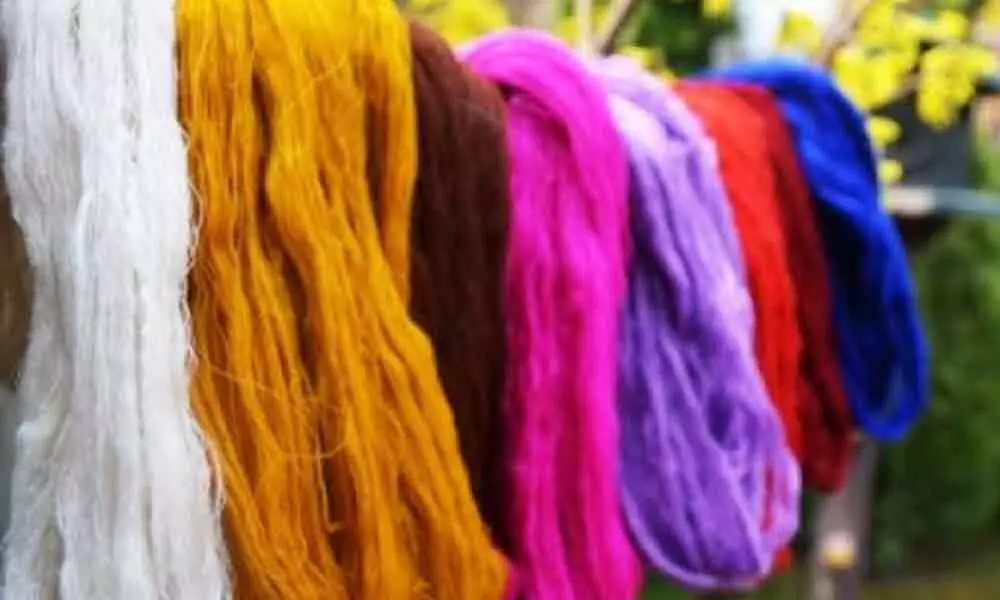Live
- First Impressions and Unboxing of the MacBook Pro M4: A Powerhouse for Professionals and Creators
- China Gears Up for Potential Trade War Amid Trump’s Tariff Threats
- Small Farmers Gain Less by Selling to Supermarkets: Study Reveals
- Why Despite the Controversy, America Is Anticipating the Mike Tyson vs. Jake Paul Fight
- Sanju Samson and Tilak Varma Shine: Record-Breaking Feats in 4th T20I Against South Africa
- India Urges $1.3 Trillion Annual Climate Support for Developing Nations
- Bad air: 106 shuttle buses, 60 extra Metro trips planned to make Delhiites give up cars
- WHO reports declining monkeypox cases in Congo
- CM Attends Kotideepotsavam on Kartika Purnima
- PKL Season 11: Raiding trio of Devank, Ayan, Sandeep help Patna Pirates rout Bengal Warriorz
Just In
Would Kashmir's Pashmina be only seen in Empress Josephine's wardrobe?


Representational Pic
Kashmir's Pashmina shawl has a centuries-old reputation and Emperor Napoleon presenting a gown made of Pashmina yarn to his queen Josephine is just one of the myriad stories eulogising the famed handwoven garment
Srinagar: Kashmir's Pashmina shawl has a centuries-old reputation and Emperor Napoleon presenting a gown made of Pashmina yarn to his queen Josephine is just one of the myriad stories eulogising the famed handwoven garment.
Pashmina shawls are woven from the fleece of domesticated, high altitude Himalayan Capra hircus goat. This special species of goat is found in the Himalayan range at high altitudes in Tibet, Ladakh and Nepal.
J&K established a goat farm of this special breed at Khuril (Nyoma) in Leh district of Ladakh in 1970s. The goat farm is now in the newly-carved Union territory of Ladakh and hosts around 1,000 Pashmina goats.
Another Pashmina goat farm is situated at Upshi, 40 kms from Leh town. In Kargil district of Ladakh region, another Pashmina goat farm is located at Khangral, 60 kms from Kargil town. This farm was established in 1996 with 30 goats.
"Pashmina yarn comes from the undercoat of the goat and is collected by using special combs. The fleece is then auctioned to bidders who pass it on to the shawl weavers. The undercoat is basically a defence mechanism by the animal to ward off the extreme cold. If the same animal is brought down to warner climates, the goat does not grow the undercoat," said a veterinarian posted at the Khuril goat farm. Officials at the farm say the fleece is sold at Rs 2,000 per kg.
"The raw material is de-haired and then the pure undercoat fleece is spun into yarn that is woven by Pashmina shawl makers into the magic garment," said Mohd Sultan, 61, a shawlmaker in the old city of Srinagar.
Kashmir has traditional shawlmaking families who specialise in making the Pashmina shawls with majority of such families concentrated in the old city area of Srinagar.
"Pashmina making has been in our family line for the last five generations. We have kept the art alive, but given the worst period of the non-availability of yarn due to COVID-19 and now the heightened tensions between India and China in Ladakh region, it is likely that the art of Pashmina shawlmaking is going to be a thing of the past," lamented Nazir Ahmad, 54, a Pashmina shawlmaker from Eidgah area of Srinagar city.
Others in the industry believe official apathy is pushing the traditional Pashmina shawlmakers into penury and oblivion. "We have been demanding support from the government not in terms of money, but by making available the Pashmina yarn at reasonable rates. This is not happening in the Valley."
"Influential people monopolise the yarn market and then use the poor shawlmakers as bonded labour. I think the magic of the Pashmina shawl is now relegated to history books," said Mohd Raza, 45, another shawlmaker whose family has been in the trade for four generations.
Making a Pashmina shawl is a painstaking and labourious task. One shawlmaker, who is otherwise known as a good weaver, takes almost one year to finish a shawl. In economic terms it means making one Pashmina shawl should earn a weaver an entire year's livelihood.
"This rarely happens given the remuneration an average Pashmina shawl maker gets. This also acts as a dampener for the shawlmaker and his family," said Gowhar, a shawl trader of Kashmir.
Given the hardships faced by this world famous industry, the only glory a Pashmina shawlmaker can boast of is the picture of the French empress Josephine sporting a gown made of the poor shawl weaver's hard labour.

© 2024 Hyderabad Media House Limited/The Hans India. All rights reserved. Powered by hocalwire.com






